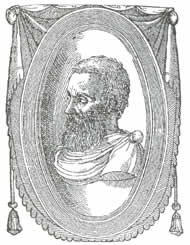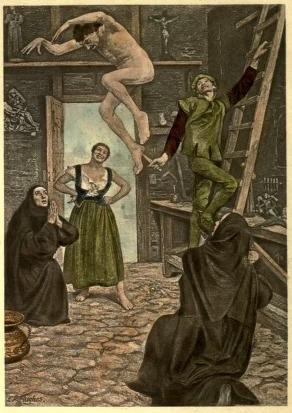|
Pierre De Larivey
Pierre de Larivey (20 July 1549 – 12 February 1619) was a French dramatist of Italian origin. He is credited with introducing the Italian "comedy of intrigue" into France. Life Little is known of Larivey's biography. The suggestion made by Pierre Grosley of Troyes that Pietro Giunti, called "Larivey" (the name Larivey or l'Arrivey would have been taken by way of translation from ''giunto'') was a member of the family of the Giunti, the famous printers of Florence and Venice, is subject to caution. Larivey's family was established at Troyes in the Champagne region. Pierre studied law in Paris, and was in close contact with the milieu of the lawyers of Parlement. He participated in a literary circle around Jean Voyer and frequented the jurist Gilles Bourdin (Larivey would write 2 sonnets to his memory) and met there the dramatists Guillaume Le Breton and François d'Amboise. He was friends with Gilles Corrozet. In 1572, he accompanied François d'Amboise into Poland, on ... [...More Info...] [...Related Items...] OR: [Wikipedia] [Google] [Baidu] |
Dramatist
A playwright or dramatist is a person who writes plays. Etymology The word "play" is from Middle English pleye, from Old English plæġ, pleġa, plæġa ("play, exercise; sport, game; drama, applause"). The word "wright" is an archaic English term for a craftsman or builder (as in a wheelwright or cartwright). The words combine to indicate a person who has "wrought" words, themes, and other elements into a dramatic form—a play. (The homophone with "write" is coincidental.) The first recorded use of the term "playwright" is from 1605, 73 years before the first written record of the term "dramatist". It appears to have been first used in a pejorative sense by Ben Jonson to suggest a mere tradesman fashioning works for the theatre. Jonson uses the word in his Epigram 49, which is thought to refer to John Marston: :''Epigram XLIX — On Playwright'' :PLAYWRIGHT me reads, and still my verses damns, :He says I want the tongue of epigrams ; :I have no salt, no bawdry he doth mea ... [...More Info...] [...Related Items...] OR: [Wikipedia] [Google] [Baidu] |
The Miser
''The Miser'' (french: L'Avare; ; also known by the longer name ''L'Avare ou L'École du Mensonge,'' meaning The Miser, or the School for Lies) is a five-act comedy in prose by the French playwright Molière. It was first performed on September 9, 1668, in the theatre of the Palais-Royal in Paris. The play The play was first produced when Molière's company was under the protection of Louis XIV. It was loosely based on the Latin comedy ''Aulularia'' by Plautus, from which many incidents and scraps of dialogue are borrowed, as well as from contemporary Italian farces. The miser of the title is called Harpagon, a name adapted from the Greek ἁρπάγη pronounced ''harpágay'', meaning a hook or grappling iron (ἁρπάγη < ἁρπάζω = grab). He is obsessed with the wealth he has amassed and always ready to save expenses. Now a widower, he has a son, Cléante, and a daughter, Élise. Although he is over sixty, he is attempting to arrange a marriage between himself and an ... [...More Info...] [...Related Items...] OR: [Wikipedia] [Google] [Baidu] |
Pope Pius II
Pope Pius II ( la, Pius PP. II, it, Pio II), born Enea Silvio Bartolomeo Piccolomini ( la, Aeneas Silvius Bartholomeus, links=no; 18 October 1405 – 14 August 1464), was head of the Catholic Church and ruler of the Papal States from 19 August 1458 to his death in August 1464. He was born at Corsignano in the Sienese territory of a noble but impoverished family. He was a Renaissance humanist, famous as an author in Latin before he became pope. His longest and most enduring work is the story of his life, the ''Commentaries'', which is the only revealed autobiography ever to have been written by a reigning pope. This was only published in 1584. Early life Aeneas was born to Silvio, a soldier and member of the House of Piccolomini, and Vittoria Forteguerri, who had 18 children including several twins, though most died at a young age. He worked with his father in the fields for some years and at age 18 left to study at the universities of Siena and Florence. He settled in the f ... [...More Info...] [...Related Items...] OR: [Wikipedia] [Google] [Baidu] |
Giovanni Francesco Straparola
Giovanni Francesco "Gianfrancesco" Straparola, also known as Zoan or Zuan Francesco Straparola da Caravaggio (ca. 1485?–1558), was an Italian writer of poetry, and collector and writer of short stories. Some time during his life, he migrated from Caravaggio to Venice where he published a collection of stories in two volumes called '' The Facetious Nights'' or '' The Pleasant Nights''. This collection includes some of the first known printed versions of fairy tales in Europe, as they are known today. Biography Life Not much is known of Straparola's life except for a few facts regarding his published works. He was likely born some time around 1485 in Caravaggio, Italy (on the Lombard plain east of Milan). However, nothing more is known of his life until 1508 when he was found to be in Venice where he signed his name "Zoan" on the title page of his ''Opera nova de Zoan Francesco Straparola da Caravaggio novamente stampata'' (''New Works''). Prior to issuing the first volume of ... [...More Info...] [...Related Items...] OR: [Wikipedia] [Google] [Baidu] |
The Facetious Nights Of Straparola
''The Facetious Nights of Straparola'' ( 1550–1555; Italian: ''Le piacevoli notti''), also known as ''The Nights of Straparola'', is a two-volume collection of 75Nancy Canepa. "Straparola, Giovan Francesco (c. 1480–1558)" in ''The Greenwood Encyclopedia of Folktales and Fairy Tales'', 3-volumes, edited by Donald Haase, Greenwood Press, 2008, pages 926–27. stories by Italian author and fairy-tale collector Giovanni Francesco Straparola. Modeled after Boccaccio's ''Decameron'', it is significant as often being called the first European storybook to contain fairy-tales; it would influence later fairy-tale authors like Charles Perrault and Jacob and Wilhelm Grimm. History ''The Facetious Nights of Straparola'' was first published in Italy between 1550–53 under the title ''Le piacevoli notti'' (''"The Pleasant Nights"'') containing 74 stories. In 1555 the stories were published in a single volume in which one of the tales was replaced with two new tales, bringing the total to ... [...More Info...] [...Related Items...] OR: [Wikipedia] [Google] [Baidu] |
Luigi Pasqualigo
Luigi Pasqualigo (1536–1576) was a Venetian soldier and man of letters who wrote the play ''Il Fedele'' that was adapted by the English playwright Anthony Munday under the title, ''Fidele and Fortunio'' (1584). According to his brother, he was "more a follower of Mars than of Apollo". Pasqualigo apparently took part in the Battle of Lepanto of 1571. He is named as commander of the Spanish galleon ''Idra'' (Hydra) of Naples which was stationed on the left wing of the battle. Publications * ''Dalle Lettere Amorose'', Libri Quattro, Vinegia, 1573, 1581 and 1607. * ''Il Fedele'', Venezia, Bolognino Zaltieri, 1576. * ''Il Fedele'', Comedia…Di Novo Ristampata, e ricorretta, Venetia, appresso Francesco Zinetti, 1579. * ''Il Fedele'', a cura di Francesca Romana de’Angelis, Roma, E & A editori associati, 1989. * ''Gl'Intricati'', (pastoral romance), 1581. * ''Rime Volgari'', Venetia, appresso Gio.Battista Ciotti, 1605. Influences Plays influenced by Pasqualigo's play, ''Il Fedele' ... [...More Info...] [...Related Items...] OR: [Wikipedia] [Google] [Baidu] |
Three Unities
The classical unities, Aristotelian unities, or three unities represent a prescriptive theory of dramatic tragedy that was introduced in Italy in the 16th century and was influential for three centuries. The three unities are: #''unity of action'': a tragedy should have one principal action. #''unity of time'': the action in a tragedy should occur over a period of no more than 24 hours. #''unity of place'': a tragedy should exist in a single physical location. History Italy In 1514, author and critic Gian Giorgio Trissino (1478 – 1550) introduced the concept of the unities in his blank-verse tragedy, ''Sofonisba''. Trissino claimed he was following Aristotle. However, Trissino had no access to Aristotle's most significant work on the tragic form, ''Poetics''. Trissino expanded with his own ideas on what he was able to glean from Aristotle's book, ''Rhetoric''. In ''Rhetoric'' Aristotle considers the dramatic elements of action and time, while focusing on audience reception. Po ... [...More Info...] [...Related Items...] OR: [Wikipedia] [Google] [Baidu] |
Girolamo Razzi
Girolamo is an Italian variant of the name Hieronymus. Its English equivalent is Jerome. It may refer to: * Girolamo Cardano (1501–1576), Italian Renaissance mathematician, physician, astrologer and gambler * Girolamo Cassar (c. 1520 – after 1592), Maltese architect and military engineer * Girolamo da Cremona ( fl. 1451–1483), Italian Renaissance painter * Girolamo della Volpaia, Italian clock maker * Girolamo Fracastoro (1478–1553), Italian physician, scholar, poet and atomist * Girolamo Frescobaldi (1583–1643), Italian musician * Girolamo Maiorica (c. 1591–1656), Italian Jesuit missionary to Vietnam * Girolamo Luxardo (1821–), Italian liqueur factory * Girolamo Masci (1227–1292), Pope Nicholas IV (1288–1292) * Girolamo Palermo, American mobster * Girolamo Porro (c. 1520 – after 1604), Italian engraver * Girolamo Riario (1443–1488), Lord of Imola and Forlì * Girolamo Romani (1485–1566), Italian High Renaissance painter * Girolamo Savonarola (1452–1498), ... [...More Info...] [...Related Items...] OR: [Wikipedia] [Google] [Baidu] |
Vincenzo Gabbiani
Vincenzo is an Italian male given name, derived from the Latin name Vincentius (the verb ''vincere'' means to win or to conquer). Notable people with the name include: Art *Vincenzo Amato (born 1966), Italian actor and sculptor *Vincenzo Bellavere (c.1540-1541 – 1587), Italian composer *Vincenzo Bellini (1801–1835), Italian composer *Vincenzo Camuccini (1771–1844), Italian academic painter *Vincenzo Catena (c. 1470 – 1531), Italian painter *Vincenzo Cerami (1940–2013), Italian screenwriter *Vincenzo Consolo (1933–2012), Italian writer *Vincenzo Coronelli (1650–1718), Franciscan friar, cosmographer, cartographer, publisher, and encyclopedist *Vincenzo Crocitti (1949–2010), Italian cinema and television actor *Vincenzo Dimech (1768–1831), Maltese sculptor *Vincenzo Galilei (1520–1591), composer, lutenist, and music theorist, father of Galileo *Vincenzo Marra (born 1972), Italian filmmaker *Vincenzo Migliaro (1858–1938), Italian painter *Vincenzo Natali (bo ... [...More Info...] [...Related Items...] OR: [Wikipedia] [Google] [Baidu] |
Antonio Francesco Grazzini
Antonio Francesco Grazzini or Antonfrancisco Grazzini (March 22, 1503February 18, 1584) was an Italian author." Biography He was born at Florence or in Staggia Senese (he wrote of himself: '''Rime di Antonfrancesco detto il Lasca'', parte prima, Stamperia di Francesco Moucke, Firenze 1741, pag. XXI.) of a good family, but there is no record of his upbringing and education. He probably began to practise as an apothecary as a youth; and owned the then famous Farmacia del Moro near the Cathedral. In 1540 he was among the founders of the Accademia degli Umidi, which was soon renamed Accademia Fiorentina. He later took a leading role in the establishment of the more famous Accademia della Crusca, which published his ''Vocabulario'' of words accepted as the purest Italian. To both societies he was known as Il Lasca or Leuciscus, a pseudonym which is still frequently substituted for his proper name. Grazzini was temperamental, his life consequently enlivened or disturbed by various ... [...More Info...] [...Related Items...] OR: [Wikipedia] [Google] [Baidu] |




